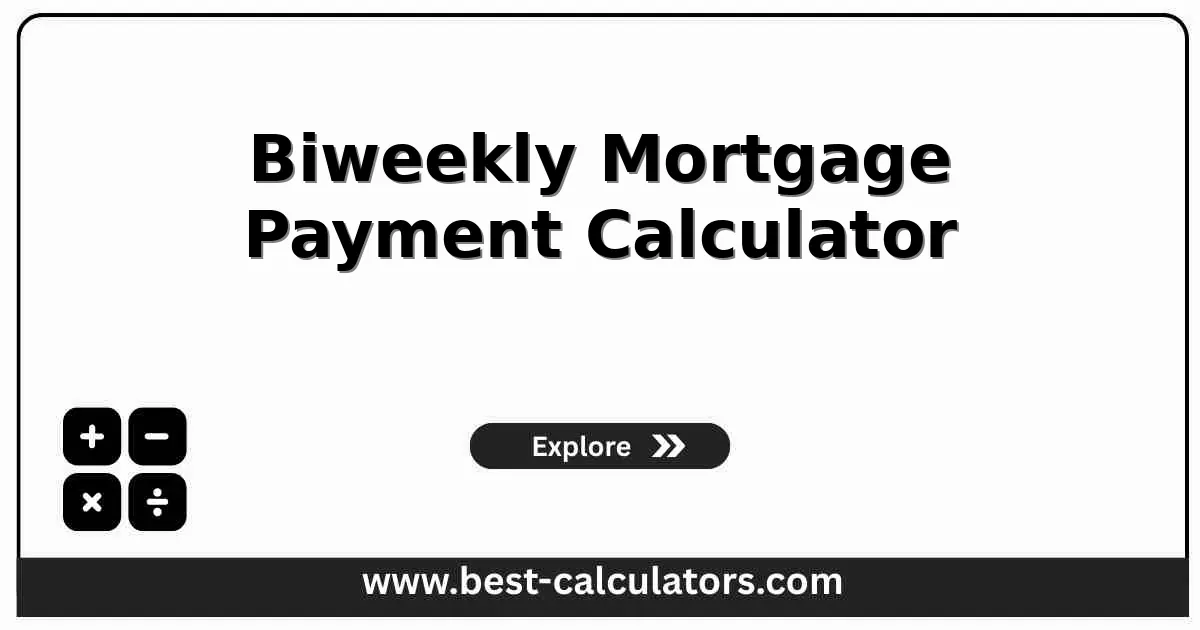Biweekly Mortgage Payment Calculator
Free biweekly mortgage calculator to determine payment amounts, interest savings, and time saved with biweekly payments
Biweekly Mortgage Calculator
Results
What is a Biweekly Mortgage Payment Calculator?
A biweekly mortgage payment calculator is a financial tool that determines payment amounts and savings when paying your mortgage every two weeks instead of monthly. By making 26 biweekly payments (equivalent to 13 monthly payments) annually, you accelerate principal reduction, significantly decrease total interest paid, and shorten your loan term by several years.
This calculator helps with:
- Payment planning - Calculate exact biweekly payment amounts
- Interest savings - Determine total interest reduction over loan life
- Time savings - Calculate years saved on mortgage payoff
- Budget analysis - Evaluate affordability of accelerated payments
- Strategy comparison - Compare biweekly vs monthly payment benefits
For comprehensive mortgage payment analysis, use our mortgage calculator to evaluate monthly payments including principal, interest, taxes, and insurance.
When considering refinancing, explore our refinance calculator to determine if refinancing saves money versus biweekly payments.
To view complete payment schedules, our mortgage amortization calculator shows detailed principal and interest breakdowns over time.
How Biweekly Mortgage Payments Work
Biweekly mortgage payments use a simple but powerful principle to accelerate loan payoff:
Annual Payments = Biweekly Payment × 26
Extra Annual Payment = Biweekly Payment × 2
Why It Works:
- 26 biweekly payments = 13 monthly payments (not 12)
- Extra payment goes entirely to principal reduction
- Lower principal balance reduces future interest charges
- Accelerated payoff shortens loan term significantly
Example: $200,000 loan at 5% for 30 years. Monthly payment = $1,074. Biweekly payment = $537. Annual biweekly total = $13,962 vs. monthly total = $12,888. The extra $1,074 annually saves approximately $34,000 in interest and pays off the loan 4.5 years early.
The savings compound over time as each extra payment reduces the principal balance, decreasing future interest calculations and accelerating equity building substantially.
Key Concepts Explained
Payment Frequency
Biweekly = every 2 weeks (26 times yearly). Monthly = once per month (12 times yearly). The difference creates one extra full payment annually.
Principal Acceleration
Extra payments go directly to principal, reducing balance faster. Lower principal means less interest charged on future payments.
Interest Savings
Reduced loan term and lower principal balance significantly decrease total interest paid over mortgage lifetime, often saving tens of thousands.
Equity Building
Accelerated principal paydown builds home equity faster, providing more financial flexibility and wealth accumulation over time.
How to Use This Calculator
Enter Loan Amount
Input your current mortgage balance or planned loan amount (e.g., $200,000)
Add Interest Rate
Enter your mortgage interest rate percentage (e.g., 5.0%)
Specify Loan Term
Input remaining loan term in years (e.g., 30 years)
View Biweekly Payment
See your biweekly payment amount (half of monthly payment)
Analyze Savings
Review total interest savings and years saved with biweekly payments
Evaluate Affordability
Ensure annual payment total fits your budget before switching payment plans
Benefits of Biweekly Mortgage Payments
- • Massive Interest Savings: Save thousands to tens of thousands in total interest over loan lifetime through accelerated principal reduction and shortened term.
- • Faster Loan Payoff: Pay off mortgage 4-6 years earlier on 30-year loans without increasing individual payment amounts significantly.
- • Budget-Friendly Approach: Aligns with biweekly paychecks for easier budgeting, making extra payment less noticeable than lump-sum annual payments.
- • Accelerated Equity Building: Build home equity faster through principal reduction, increasing net worth and borrowing capacity for future needs.
- • Automatic Discipline: Automated biweekly payments create consistent saving habit without requiring active decision-making or willpower.
- • Financial Freedom Sooner: Eliminate mortgage debt years earlier, freeing up income for retirement savings, investments, or other financial goals.
Factors Affecting Biweekly Payment Savings
1. Interest Rate Level
Higher interest rates create larger savings through biweekly payments. Lower rates reduce savings magnitude but still provide meaningful benefits.
2. Remaining Loan Term
Longer remaining terms provide greater savings potential. Starting biweekly payments early in loan maximizes interest reduction and time saved.
3. Loan Balance Size
Larger loan balances generate proportionally larger interest savings. Extra principal payments have greater impact on substantial balances.
4. Lender Fees
Some lenders charge biweekly program fees ($300-500 setup plus $2-5 per payment). Factor fees into savings calculations or make extra payments yourself.
5. Payment Timing
True biweekly programs credit payments immediately. Some lenders hold payments until full monthly amount accumulates, reducing savings benefits.

Frequently Asked Questions (FAQ)
Q: What is a biweekly mortgage payment?
A: Half your monthly payment paid every two weeks (26 yearly payments). Equals 13 monthly payments annually, accelerating principal paydown and reducing interest.
Q: How much can I save with biweekly payments?
A: Typically save 4-6 years on 30-year mortgages and thousands in interest. $200K at 5% saves $30K+ in interest, paid off 4-5 years early.
Q: Can I switch to biweekly payments?
A: Yes, contact your lender for biweekly programs. Some free, others charge fees. Alternatively, make extra principal payments monthly for similar savings.
Q: Is biweekly better than monthly payments?
A: Better if you can afford extra annual payment (one extra monthly payment yearly). Reduces interest and builds equity faster. Monthly provides more flexibility.
Q: Do all lenders accept biweekly payments?
A: Not all offer automatic programs. Replicate savings by making one extra monthly payment yearly or adding extra principal to regular payments.
Q: Are there any drawbacks to biweekly payments?
A: Less cash flow flexibility and potential lender fees. Ensure you can afford the extra payment before committing to biweekly schedule.